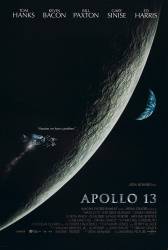Question: I've always wondered about one scene in the movie. It happens when Tom Hanks says, "prepare for a little jolt, fellas." We see the astronauts being propelled forward in their seats as the spacecraft accelerates very quickly. But the only time you'd be going forward was if you were riding in a car and the brakes were suddenly slammed on, right? Can someone explain this to me?
Answer: While this did actually happen on Apollo 13 it was completely unexpected, the "get ready for a little jolt" line was made up for the movie. There are retro rockets on the S1-C (first) stage of the Saturn V that are supposed to fire at separation to slow the S1-C and create more separation before the S-2 ignites. The retros fired one second early on this mission so it was before separation and the unexpected reverse thrust is what caused them to get thrown forward. Apparently Jim Lovell even had marks on his helmet from hitting it on the panel when this happened.
Answer: You have to think three-dimensionally. The rocket is travelling upwards under the thrust of the first stage - the moment that thrust cuts off, the only force acting on the ship is gravity, so it's effectively as if the brakes have been slammed on, relatively speaking, as they are no longer moving forwards anywhere near as fast. Then the second-stage engines kick in, propelling them upwards at speed again, pushing them back into their seats.
Question: Did the scene where the astronauts take off their bio-med sensors really happen?
Answer: According to transcripts of the actual mission's audio recordings, yes. Though the movie can be lauded for its extent of accuracy, it still has moments of artistic license. In the transcripts, the last reference to BIOMED is between Cap Comm (CC) and Jim Lovell (CDR). CC: "The other thing is, if anyone has on any BIOMED, would you switch your switch to __ your BIOMED switch to that position." CDR: "Understand the first, Vance, and no-one has on any BIOMED__." CC: "Okay." CDR: "Fred and Jack are maneuvering things around right now, and mine is long since departed the scene."
Question: What caused the oxygen tank to explode?
Answer: Other answer is not entirely correct. The O2 tank was dropped in the North American factory, but they were unable to find any damage so they installed it on the Apollo 13 SM. 2 years later the spacecraft was sitting on the pad at Kennedy and they did the "plugs out test" with the spacecraft fully fuelled and running on internal systems. After the test was completed engineers tried to drain the tank and found they couldn't, the drain tube had been damaged when it was dropped. In order to empty the tank, they decided to run the heaters all night to boil the LOX off. This introduced the second problem: The spacecraft was engineered to run on 65 volts but the tank heater and fan were engineered to run on 28 volts. NASA changed the spec and it didn't find it's way to the sub-sub-contractor. NASA->North American->Tank Fabricator->Sensor manufacturer. With the heater running all night at 3 times the voltage it effectively cooked the elements, burning off insulation and such. When they ran the electronics inside the tank, it exposed bare wire inside the LOX to electrical current. Two of those bare wires shorted causing the explosion.
Answer: The oxygen tank had been used previously on the Apollo 10 mission, but tests revealed a fault, so it was taken out. For Apollo 13, that tank was reused after refurbishment, but one important thing that had changed was the voltage and amperage running through it to keep the oxygen warm; it was doubled for the Apollo 13. That melted through the isolation material, causing a short, which caused the tank to explode.
Question: What caused the oxygen tank to overheat that led to the explosion?
Answer: In real life, there were a number of incidents that ended up damaging the number 2 oxygen tank, which was then installed in Apollo 13, without anyone realizing there was a dangerous problem. Exposed fan wires inside the tank caught the teflon lining of the tank on fire when the power fans were turned on for the third time. The following website explains the pre-flight issues that damaged the tank as well as the chain reaction of events after the fire. https://nssdc.gsfc.nasa.gov/planetary/lunar/ap13acc.html.






Answer: The launch escape system, the 'spike' mounted above the command module, would fire a set of four thrusters designed to pull the command module away from the rest of the launch vehicle. Pitch thrusters fire to move the command module laterally, in order to avoid the possibility of the module being hit by the oncoming launch vehicle, or to prevent the module from landing in a dangerous location in the event of a launchpad fire. Once these thrusters have done their job, the escape system jettisons and the module lands using the onboard parachutes. The above describes what happens when the control is rotated in the counter-clockwise direction indicated by the control's legend. If the control is instead rotated in the clockwise direction then control of the rocket passes from the computers built into the Saturn V rocket (later jettisoned with the stages) to the computers built into the command module proper. This control was never used in an Apollo launch.
Tailkinker ★